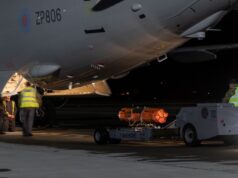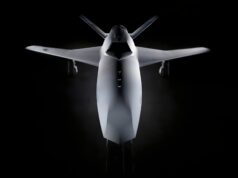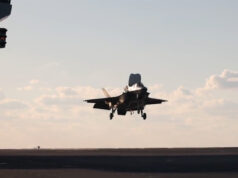Flight tracking services yesterday showed a Chinese military aircraft operating around Hainan while broadcasting the identity of Royal Air Force Typhoon ZK334 and the callsign YILO2400.
The behaviour visible on the map did not resemble the flight characteristics of a Eurofighter, obviously. The track remained close to Chinese airspace and eventually terminated on Hainan Island, close to areas known for activity by Chinese unmanned systems.
Flightradar24 relies on data from a dispersed set of volunteer receivers. The readings in this case were stable enough that the track remained visible for a significant period and showed a coherent movement pattern.
A Chinese drone appeared on FR24 using the ID of RAF Typhoon, flying a drone-like pattern around Hainan before landing on the island. A reminder of how easily ADS-B can be manipulated. pic.twitter.com/AhaSq82YDq
— UK Defence Journal (@UKDefJournal) November 20, 2025
The aircraft maintained speeds and altitudes that align more with medium altitude intelligence or surveillance drones rather than a fast jet with the performance of a Typhoon. The absence of rapid acceleration, steep climbs, or sharp turns is a big giveaway. The flight path wound around a section of airspace frequently used by Chinese military aviation and then moved toward a location that appears to host drone operations.
The use of an RAF hex code by an aircraft flying a routine pattern inside Chinese territory isn’t very alarming. The ADS-B system lacks authentication, so any aircraft equipped with a transponder that allows manual input can broadcast an identity that belongs to a completely different platform.
That technical reality has been pointed out for years by aviation researchers, and this incident shows how such a capability can surface in a real operational environment. The intention behind the choice of code remains uncertain. It could be a deliberate attempt to test identity manipulation, a misconfigured transponder on a drone undergoing trials, or a sign that China is experimenting with methods to obscure the identity of its unmanned aircraft during training flights.
It did not look like a glitch, and it did not behave like a mislabeled civilian flight. It looked like a Chinese platform using an identity it should never broadcast. For anyone who keeps an eye on this region, it is a useful reminder to check what the data shows, trust what you can verify and stay aware that some are now treating ADS-B as a tool they can shape to their own purposes.














So lets do a Brian Blessed’s Blackadder strategy by painting a Tiffy in Chinese colours then strafing the F out of Yantar ?
GlynH, do you see any China warships or warplanes near Isle of Man, Bailiwicks of Guernsey, Gibraltar? I am sure there never have been. It is our Imperial privilege to have our military up everyone’s…. God save the king!!
Don’t recall any Tiffies over Hainan either.
In other , totally unrelated news, I see the UK government look to be approving the Chinese mega embassy in London.
So we have Reform MP’staking bribes from Russia , and Labour sycophantically ‘assuming the position’ for the Chinese.
Who can you trust to protect this country , its security , and its values in UK Politics – I’d now suggest no-one.
Its about time this was given the seriousness it deserves.
All MP’s should be investigated, and , where seditious intent from a foreign power to influence is identified , imprisoned- no exceptions.
I can’t believe the government are letting the Chinese build this super Embassy specially after been told by Mi5 & Mi6 our security services that it’s unwise .This government say the word ,first duty of government is to defend the Realm ? They talk about Russia which we all know will do anything two disrupt the U.K. and other nations with bad intentions and they very well.know China are in the same book has Russia just on a different page . Come on Prime minister starmer get some back bone no wonder Trump in reality thinks your a puppet . 🙄
None of today’s political parties are fit to govern Britain in this horrible new reality. They’re living like it’s the 1790s, when our main enemy was France, and it was ok to imprison any British person who speaks out about government corruption. Seriously, look at the history of that period. Constantly at war, rampant inflation, a government prepared to brutally suppress whatever it saw as dissent. It’s all happening again.
Except today, none of our enemies share cultural or religious ties with us, and don’t share our sense of ethics or morality. They’d wipe us off the map and celebrate in the streets at images of families, schools and hospitals going up in flames.
I’m sure that after much delay and bluster, there will be a series of committees and wargaming strategies over the next 2 to 5 years with lots of fighting talk about commitments to our allies, we must protect Britain etc; even as Labour further demonises British values so that when the time comes, nobody wants to defend such a “vile” nation, and Labour’s foreign masters carve us up and they all make a lot of money from it.
Assuming the worst doesn’t happen, maybe they’ll put out a reassuring statement about having a bigger RAF and RN by 2040 or 2060, never mind that China is allegedly going to start a war in 2027 and Russia started one in 2022.
Poet, or would you love to go to war at a drop of the hat like the American Empire. They merely spent 4 trillion on Afghanistan, Iraq wars, so far– accomplished only making more terrorists . And is on a permanent decline. The British Empire is no longer, due to war expenses. So, Russia started the war!? Or they were backed into a corner.— most military officers fear cornering an enemy, they fight out……
Sometimes old Donnie is more cunning than the military. He is willing to surrender corrupt Ukraine, infested with Nazi’s, than losing more trillion$$ on 20 year wars. Zelensky is in tremendously fear, does he take the 28 point plan now, or get destroyed this winter! Europe has no money for war, EU is in recession, and UK? Not likely
Britain had plenty of pro-Nazi sympathisers in the 1930s and everywhere has its fair share of corruption. These are not reasons to abandon Ukraine. “Old Donnie” himself is morally and financially corrupt and politically not too many goose steps away from a National Socialist ideology, although I expect his supporters would rather hear him called a Nazi than a Socialist.
Your Russian narrative tells us you are a Putin sympathiser and we in the UK are already in a greyzone war with Russia. Your counsel of appeasment falls on deaf ears. Ukraine can outlast Putin if we continue to support it, however many more years that takes (it’s Putin they are fighting, not Russia). Three years from now Old Donnie will be on his way out. It will be a long three years for many people, including the people of Ukraine.
😂😂😂what a crock of shite.
I see English isn’t you first language – I wonder what is.